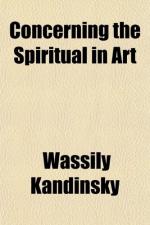Painting is an art, and art is not vague production, transitory and isolated, but a power which must be directed to the improvement and refinement of the human soul—to, in fact, the raising of the spiritual triangle.
If art refrains from doing this work, a chasm remains unbridged, for no other power can take the place of art in this activity. And at times when the human soul is gaining greater strength, art will also grow in power, for the two are inextricably connected and complementary one to the other. Conversely, at those times when the soul tends to be choked by material disbelief, art becomes purposeless and talk is heard that art exists for art’s sake alone.
[Footnote: This cry “art for art’s sake,” is really the best ideal such an age can attain to. It is an unconscious protest against materialism, against the demand that everything should have a use and practical value. It is further proof of the indestructibility of art and of the human soul, which can never be killed but only temporarily smothered.]
Then is the bond between art and the soul, as it were, drugged into unconsciousness. The artist and the spectator drift apart, till finally the latter turns his back on the former or regards him as a juggler whose skill and dexterity are worthy of applause. It is very important for the artist to gauge his position aright, to realize that he has a duty to his art and to himself, that he is not king of the castle but rather a servant of a nobler purpose. He must search deeply into his own soul, develop and tend it, so that his art has something to clothe, and does not remain a glove without a hand.
The artist must have something to say, for mastery over form is not his goal but rather the adapting of form to its inner meaning.
[Footnote: Naturally this does not mean that the artist is to instill forcibly into his work some deliberate meaning. As has been said the generation of a work of art is a mystery. So long as artistry exists there is no need of theory or logic to direct the painter’s action. The inner voice of the soul tells him what form he needs, whether inside or outside nature. Every artist knows, who works with feeling, how suddenly the right form flashes upon him. Bocklin said that a true work of art must be like an inspiration; that actual painting, composition, etc., are not the steps by which the artist reaches self-expression.]
The artist is not born to a life of pleasure. He must not live idle; he has a hard work to perform, and one which often proves a cross to be borne. He must realize that his every deed, feeling, and thought are raw but sure material from which his work is to arise, that he is free in art but not in life.
The artist has a triple responsibility to the non-artists: (1) He must repay the talent which he has; (2) his deeds, feelings, and thoughts, as those of every man, create a spiritual atmosphere which is either pure or poisonous. (3) These deeds and thoughts are materials for his creations, which themselves exercise influence on the spiritual atmosphere. The artist is not only a king, as Peladan says, because he has great power, but also because he has great duties.




